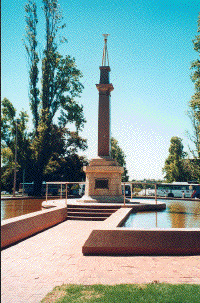William Light
Colonel William Light known as the Founder of Adelaide
was born on 27 April 1786 in Kuala Kedah Malaya, the son
of Captain Francis Light, founder and governor of Penang
and Martinha Rozells. At the age of six, he was sent to
England to be schooled at Theberton SFK. When he was fourteen
years old he joined the British Navy and Army and undertook
a career which at times bordered on controversy. He married
Miss Elizabeth Perois on 29 May 1821 in Londonderry LDY,
where he was stationed. On 16 October 1824 he married Mary
Bennet, daughter of the Duke of Richmond.
He came to the notice of the men establishing the colony
of South Australia through his association with John Hindmarsh
who was to become the first governor of the colony. Both
Hindmarsh and Light were involved as mercenaries for the
Pasha of Egypt and both applied for the vice regal position
in South Australia. Seemingly Light was overlooked for the
top posts, but his backers finally secured him the post
of Surveyor-General to oversee the surveying of the colony's
settlements including the proposed capital city, Adelaide.
While Hindmarsh, as governor, was the undoubted leader,
Light alone had the responsibility for determining the location
of Adelaide.
 Recent research by Professor Donald Johnson, reminds us
that not only was the siting of Adelaide, Light's only responsibility,
but that the man headed up a team of thoroughly professional
surveyors who did most of the foot work and to name Light
as the Founder of Adelaide was very generous of
the founding fathers! Indeed the renowned plan for Adelaide
was developed in England in 1835 by civil engineer, George
Strickland Kingston appointed as surveyor, by October 1835
and Light was not appointed until the following January
1836. Moreover, on arrival in the new colony, it was Kingston
who located the current site and recommended it to Light.
It was Kingston and his team and not the sickly Light who
surveyed the site and moulded the 1835 plan to fit the local
topography.
Recent research by Professor Donald Johnson, reminds us
that not only was the siting of Adelaide, Light's only responsibility,
but that the man headed up a team of thoroughly professional
surveyors who did most of the foot work and to name Light
as the Founder of Adelaide was very generous of
the founding fathers! Indeed the renowned plan for Adelaide
was developed in England in 1835 by civil engineer, George
Strickland Kingston appointed as surveyor, by October 1835
and Light was not appointed until the following January
1836. Moreover, on arrival in the new colony, it was Kingston
who located the current site and recommended it to Light.
It was Kingston and his team and not the sickly Light who
surveyed the site and moulded the 1835 plan to fit the local
topography.
Colonel Light’s controversial encounters with bureaucracy
was to end in his dismissal. Shunned by Adelaide society
for living with a woman, he became too ill by January 1839
to work and eventually was too weak to leave his bed at
his Thebarton home and was nursed by his companion, supporters
and friends.
Boyle Travers Finniss (an assistant surveyor, then Light's
business partner and subsequently the Colony’s first
Premier) and his wife did what they could to help and console
the dying man. Finniss tried to get the Colonial Chaplain,
Revd Charles Beaumont Howard, to visit Light when he was
dying, but Howard would not because of Light’s refusal
to repent and end his liaison with Maria Gandy.
Light died on 6 October 1839 with Finniss and Woodforde
in attendance. While scant attention was given to Light
by the authorities, this attitude changed after his death
and on 10 October there was a most impressive funeral with
a service held in Trinity Church by the Colonial Chaplain.
Guns were fired in salute and the body taken in a grand
procession for burial in Light Square.
Inside the coffin was a brass breastplate inscribed, Founder
of Adelaide. The Register with its columns
bordered in black, gave a lengthy description of the service
and claimed that nearly 450 gentlemen, all in deep mourning,
followed the body from the Church to the Square.
There is little doubt that Light played a significant role
in the location of Adelaide in that he determined by November
1836 that the city would be best placed on the Adelaide
Plains, but it was only through the urging of Kingston and
the support of others including that of influential John
Morphett, that we have the selection of the actual site.
See
report.
|